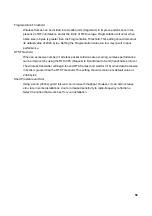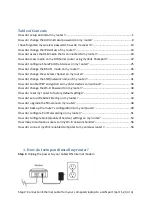
62
DMZ Setting
DMZ means "Demilitarized Zone." If an application has trouble working from behind the router,
you can expose one computer to the Internet and run the application on that computer.
When a LAN host is configured as a DMZ host, it becomes the destination for all incoming
packets that do not match some other incoming session or rule. If any other ingress rule is in
place, that will be used instead of sending packets to the DMZ host; so, an active session,
virtual server, active port trigger, or port forwarding rule will take priority over sending a packet
to the DMZ host. (The DMZ policy resembles a default port forwarding rule that forwards every
port that is not specifically sent anywhere else.)
The router provides only limited firewall protection for the DMZ host. The router does not
forward a TCP packet that does not match an active DMZ session, unless it is a connection
establishment packet (SYN). Except for this limited protection, the DMZ host is effectively
"outside the firewall". Anyone considering using a DMZ host should also consider running a
firewall on that DMZ host system to provide additional protection.
Packets received by the DMZ host have their IP addresses translated from the WAN-side IP
address of the router to the LAN-side IP address of the DMZ host. However, port numbers are
not translated; so applications on the DMZ host can depend on specific port numbers.
The DMZ capability is just one of several means for allowing incoming requests that might
appear unsolicited to the NAT. In general, the DMZ host should be used only if there are no
other alternatives, because it is much more exposed to cyberattacks than any other system on
the LAN. Thought should be given to using other configurations instead: a virtual server, a port
forwarding rule, or a port trigger. Virtual servers open one port for incoming sessions bound for
a specific application (and also allow port redirection and the use of ALGs).
Port forwarding is rather like a selective DMZ, where incoming traffic targeted at one or more
ports is forwarded to a specific LAN host (thereby not exposing as many ports as a DMZ host).
Port triggering is a special form of port forwarding, which is activated by outgoing traffic, and for
which ports are only forwarded while the trigger is active.
Few applications truly require the use of the DMZ host. Following are examples of when a
DMZ host might be required:
‧
A host needs to support several applications that might use overlapping ingress ports such
that two port forwarding rules cannot be used because they would potentially be in conflict.
Summary of Contents for TEW-812DRU
Page 1: ...802 11ac draft 2 0 TEW 812DRU Gigabit Wireless Router TEW 812DRU Rev 0 1 User Manual ...
Page 11: ...10 ...
Page 19: ...18 ...
Page 20: ...19 Guest Network This page allows you to configure the Guest Network ...
Page 22: ...21 ...
Page 24: ...23 ...
Page 25: ...24 The device status Management ...
Page 30: ...29 This restarts the router It is useful for restarting when you are not near the device ...
Page 34: ...33 Router Status ...
Page 35: ...34 The device status ...
Page 36: ...35 IPv6 Status ...
Page 37: ...36 System log This page can be used to set remote log server and show the system log ...
Page 39: ...38 Setup LAN Setting ...
Page 48: ...47 QoS ...
Page 52: ...51 Then press Apply ...
Page 53: ...52 ...
Page 71: ...70 FTP Server Enable the FTP server to share the files on USB storage ...
Page 72: ...71 Eject Device ...
















































